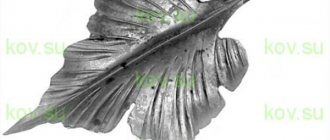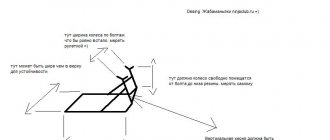Making forged leaves with your own hands
Since ancient times, forging has been considered one of the individual methods of metal processing, which allows you to create products with excellent characteristics and durability.
Before you start forging leaves, you need to make one blank sheet, which will be used to perform the remaining forging elements.
Masters of artistic forging fill their products with vitality, movement, and internal energy. Forged grape leaves and bunches, various flowers, graceful figures of animals, birds and even people transform ordinary metal into unique masterpieces.
Since the artistic forging of metal began to be used, favorite options have been practiced, which have survived to this day.
A clear example of such design decoration with forged products is considered to be a bunch of grapes, which decorate most fences and gates, balcony and window grilles, benches and gazebos in parks and squares. In addition, they decorate lanterns, pergolas, lamps, as well as canopies and awnings of entrances, and much more.
Basically, there are no such decorative structures where it would be impossible to use forged iron grapes for a designer interior.
Forged grapes belong to the plant style; along with them, additional elements are used, such as a vine, tendrils made in the form of a spiral, vines, and a varied configuration of twigs and leaves.
There are various catalogs in which you can find a variety of forging accessories with a grape motif.
What does a plant bouquet look like?
Template for forging leaves.
A set of decorative items and various forged parts have a harmonious combination, they are easy to assemble into certain patterns, each is unique and individual in its own way.
Previously, using artistic forging, elements such as flowers and grape leaves were rarely made with one’s own hands, although they are considered a traditional option.
In modern design and decoration, climbing grapes made of metal have found their wide application and are an integral part.
This product fits harmoniously into various iron structures as additional decorative items.
Forged elements, as a decorative addition that imitates plant patterns, have artistic value. When forging a vine, in order to imitate living shoots of grapes, you have to twist the bends into rings, and then the ornament using a large number of leaves takes on a living, natural look.
Technology for making forged leaves
Do-it-yourself forged leaves are as varied in structure as natural material. Nature has endowed plants with leaves of different sizes and shapes, which can be the most amazing. Likewise, during forging, the product is given the most bizarre shapes. Here are some recommendations on how to make your own leaves.
Step by step forging of leaves.
- To forge leaves with your own hands, you need to prepare a template for the product according to which the elements will be made. The first step is to transfer the sketch of the leaves. The curved lines in the drawing need to be straightened; the straight lines will subsequently be used as the axis of the sheet.
- Before forging, so that the product has the proper shape and a more natural appearance, using a drawing needle, markings in the form of dots are applied to the sketch itself.
- Thin wire, which is used for welding work, is bent so as to accurately create the contour of the future sheet, then the wire is aligned, and the markings are transferred to the axis.
- The next step is to thoroughly draw the outline, resulting in half of the required template. To completely make the model, all that remains is to bend the sketch at the axis and complete the second half, so that the result is a ready-made sample for future metal leaves. Such a sample will be used in the future as a template, along the edge of which contours are applied to the metal with a needle, and the product blank is cut out.
Using the same method, lines of veins are applied to the future sheet and, using embossing or the corrugation method, the product is made. The aesthetics of the leaves depends on the skills and carefully performed work of the master. A successful job will be done if one-sided or two-sided scanning is performed with precision.
Making forged leaves with your own hands is more profitable than ordering them, since these are products with complex design characteristics.
Forging leaves with your own hands is a very entertaining activity that requires the constant introduction of new improvements. This applies primarily to artistic and decorative elements. Beginners in this difficult task will have to gain skills and abilities for a very long time so that the completed work is of high quality and ideal form.
How to forge a grapevine
There is nothing overly complicated in the method of artistic forging of grapevines; forging grapes is a favorite activity among home and professional craftsmen.
The main stages are as follows:
- The main element of the branch is a twisted rod. Before twisting it on the machine, the rod must be prepared. If you work in a forge, the relief is applied to it by crimping with two stamps from a spring - upper and lower. If you work on cold forging machines, the bars need to be rolled through rollers.
- As a result of crimping or roller processing, a texture with cracks and grooves appears on the surface of the rods, similar to the bark of a tree. Now the rods can be twisted in any direction.
- Additional relief can be applied to the rods using a chisel or embossing technology. The plates must first be heated to forging temperature.
- The heated rod must be pulled between the plates, turning under the hammer.
- The pattern of tree bark can be obtained in a primitive way: pieces of reinforcement with different diameters are processed with a hammer and scrolled in different directions, so that the pattern is deformed and turns into something like bark.
- If you are working with a thin-walled pipe, the wood texture can be made using a plasma torch. The current strength should be very small - about 20 - 30A. Then the pipe needs to be scraped.
Forged grapes artistic forging of grapes photo
Making forged grapes with your own hands, photo of a grape storm made of metal
In the artistic forging of metal, there are some favorite solutions that are not very new ideas, but have passed the serious test of time. A classic example of such established stylistic options for decorative metal products can be considered forged grapes.
It belongs to the plant style of forging and is usually used to decorate products and household structures together with such forged elements as: metal leaves, iron vines, spiral metal grape tendrils, steel vines and variously shaped twigs made of blacksmith-forged iron. You can see an interesting photo in which you can easily see all the “spare parts” of vegetable forging with grape motifs.
The product is assembled into a finished composition and is a fragment of a forged fireplace set . I think this is a very beautiful photograph depicting artistic forging of such a style as the classical style with iron plants.
What does vegetable hodgepodge look like?
Photo of forged railings with metal grapes, bunch, vine, tendrils photo
All these decorative elements and forged parts fit very well together, easily assembled into a forging pattern that is extremely versatile and has simply fantastic flexibility. The term flexibility, in this case, is used in a figurative sense, meaning the ease of adapting an artistic solution to a wide range of shapes, sizes and dimensions of metal structures.
Let me explain in more human language.
Floral style of forging with grapes can be used almost everywhere without any problems: decorating gates, fences, gates, railings, stairs, balconies, fireplaces, window grilles, gazebos, furniture, garden benches, pergolas, lanterns, lamps, canopies, canopies and so on . It is difficult to come up with a decorative metal structure where forged grapes could not be used for design.
As an example, I want to show a photograph illustrating an example of using iron grapes to decorate a staircase, or rather in a sketch of a forged railing with bunches of grapes. Let's look at a beautiful photo of artistic forging of a railing for a staircase in a private house.
We manufacture and install railings for stairs, balcony railings, porch railings, fences , gates , wickets, gazebos, furniture, fireplace sets , garden benches, chandeliers, lamps, lanterns, pergolas and stands for flowers with grapes. How to contact us is indicated on the website.
Where can you see metal forging of grapes in the photo?
Photo of forged grapes. The forged grapes are painted with hammer enamel - a beautiful picture of the classic style of metal forging.
Usually, iron grapes can be seen in photographs posted on artistic forging websites. All blacksmiths of the classical school must master the technology of making metal grapes from forged parts.
Our website for artistic metal forging in Dnepropetrovsk is no exception. We have placed our works in the text of this article in the form of small miniatures. Each picture of an iron grape is clickable, that is, it is enlarged to view the image of forged elements in a large size.
On my own behalf, I can add that these are very beautiful photos of artistic metal forging, photographs of the author’s hand-forged works in the best forge in Dnepropetrovsk.
Seeing excellent photographs of forged elements and decorative details, which are essentially small sculptures that emerged from under the hammer and anvil of an experienced craftsman, is in itself a pleasant pastime.
How to paint grapes?
Any decorative metal structures must be painted. On the street, paint will protect the iron from corrosion, but in the interior we do not use such durable paints, but use beautiful decorative coatings. What is the best way to paint iron grapes? Painting artistic forging products is a delicate matter. Especially if it is handmade for design.
Blacksmithing in Dnepropetrovsk usually practices painting forged grapes with patina. Using blacksmith's patina for painting, you can make copper grapes, bronze, gold, silver with your own hands.
A relatively rare way to paint iron grapes is to cover grapes with hammer enamel or powder paint. You can see what grapes made of metal painted with powder paint look like by looking at the photo - how to paint grapes.
Artistic forging of grapes - painting leaves with patina photo
Patination of artistic forging products allows you to achieve other visual effects and, in my opinion, is better suited for beautiful painting of plant-style elements.
Look at the photo where you can see an example of patination, covering a grape leaf with patina. Compare with the impression that hammer enamel produces on similar parts of similar size and shape.
This opportunity doesn't come around often.
Buy metal grapes and related forged elements of plant style
You already know where to buy forged grapes. Since we are now on the website of the blacksmith workshop in Dnepropetrovsk, you can contact us regarding production, purchase, price, cost and other issues. Logical?
There are two options for buying steel grapes from a forge.
The first is that forged grape bunches are sold as separate, independent elements of iron design. Designed for making artistic forging products with your own hands and attached to structures using conventional welding.
Image in the photo: iron grapes artistic forging bottle holder
The second is to order a finished metal product , fully functional, instructing the blacksmith to decorate it himself with bunches of forged grapes, including them in the sketch of the iron design in the best possible way.
The intermediate stage of cooperation with the buyer of forged metal grapes is the approval of a sketch of forging in a floral style.
A very convenient option, you receive a completely finished product of classic hand forging in a floral style, taking into account your wishes during the manufacturing process.
How to make grapes from metal with your own hands?
The technology for making forged grapes with your own hands at home is relatively simple. The stumbling block is usually ordinary balls. In a forge, a master solves this issue easily, thanks to the use of a forge hammer and a special stamp.
He heats the iron rod to a bright red color and, with strong blows of the hammer on the stamp, chops off pieces of metal, each of which immediately takes on the characteristic shape of a grape.
When making a bunch of grapes, several stamps are used, which allow you to assemble a bunch with your own hands, not from identical iron berries - this is not very beautiful, but by combining grapes of different shapes and sizes. Which then gives the product with grape forging a more natural look.
If there is no forge, forge and hammer?
If you do not have a home forge or a mini forge in a private house, then in order to make grapes from metal you have to use ready-made iron balls.
Where can I get balls for making grapes from iron with my own hands at home? The source of metal balls is simple and original - these are bearings.
Follow the rule - it is best to place balls of not the same size in one bunch of grapes, but at least two, preferably three, diameters.
Assembling a metal grape thunderstorm
The idea of assembling the balls and forming an iron grape thunderstorm is to not try to weld the balls together. With this method of making grapes from metal, in any case, unsightly and very noticeable welds, spots, drops, and splashes are obtained.
Intermediate operation
To make a bunch of forged grapes, first a piece of an iron rod, quite thin, is welded to each ball; it is better to take wire. When forming a bunch, it is not the balls themselves that are welded, but their wire tails.
This allows you to get a clean and neat surface of a bunch of forged grapes, hide the welded joints inside, making them invisible to the viewer.
Who will only have to look at a very beautiful vegetable forging product made by you with your own hands at home.
Where to attach a bunch of grapes made of forged metal
Photography technology for making grapes, artistic forging of plants from metal. Forge in Dnepropetrovsk photo.
Now the last question. Well, we were able to learn how to make forged grapes, select the correct diameter of the balls, and mastered the technology of assembling the product.
What's next? Where to secure a bunch of forged grapes? This is where we remember those related decorative metal parts and forging elements that harmonize well with iron grapes.
It is best to attach metal grape bunches by welding through wire tails, directly to a forged vine, made in advance from a metal rod of a suitable diameter in proportion. We look at the photo of forged grapes and iron vines.











